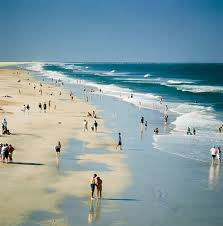
Anastasia State Park
Anastasia State Park includes more than 1,600 acres featuring four miles of pristine beach, a tidal salt marsh, and a maritime and upland hammock. There is also an archaeological site where coquina rock was mined to create the nearby fortress, Castillo de San Marcos National Monument. At Anastasia you can enjoy camping, beachcombing, swimming, picnicking, fishing, windsurfing, hiking, wildlife viewing, boating and more. Anastasia's full-facility campground, including 139 campsites, is located in a wooded area within easy bicycling or walking distance of the beach. A self-guided nature trail takes hikers through a maritime hammock on ancient sand dunes, and anglers have the opportunity to haul in the big catch. 904.460.9111. Visit
floridastateparks.org
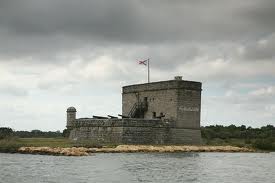
Fort Matanzas National Monument
Coastal Florida was a major field of conflict as European nations fought for control in the New World. As part of this struggle, Fort Matanzas guarded St. Augustine’s southern river approach. The colonial wars are over, but the monument is still protecting—not just the historic fort, but also the wild barrier island and the plants and animals who survive there amidst a sea of modern development. The park is situated near the site of the killing of nearly 250 French Huguenots by the Spanish, an act that gave gave the river and inlet the name Matanzas, Spanish for "slaughters", as European nations fought for control of the New World. One hundred seventy-five years later, the small watchtower fort was constructed to help protect St. Augustine from a new threat - the British. Today, the story of survival continues as human pressures encroach upon the peacefulness of the woodlands, beach, and salt marsh. Located at 8635 A1A South. 904.471.0116. Visit
nps.gov
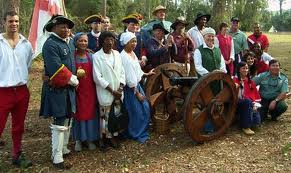
Fort Mose Historic State Park: The Birthplace of Freedom
Hidden away in the marshes of St. Augustine, Florida is one of the most important sites in American history: the first free community of ex-slaves, founded in 1738 and called Gracia Real de Santa Teresa de Mose or Fort Mose. More than a century before the Emancipation Proclamation, slaves from the British colonies were able to follow the original "Underground Railroad" which headed not to the north, but rather south, to the Spanish colony of Florida. There they were given their freedom, if they declared their allegiance to the King of Spain and joined the Catholic Church. Fort Mose was the northern defense of St.Augustine, the nation's oldest city. Learn more about the story of Fort Mose in our newly constructed visitor center and museum or explore the grounds. Located at 15 Fort Mose Trail. 904.823.2232. Visit fortmose.org
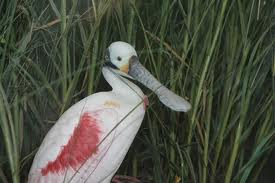
Guana Tolomato Matanzas National Estuarine Research Reserve
Guana Tolomato Matanzas National Estuarine Research Reserve is dedicated to the conservation of natural biodiversity and cultural resources through research and monitoring to guide science-based stewardship and education strategies. GTM Research Reserve protects 73,352 acres south of the City of Jacksonville (Duval County) in St. Johns County and Flagler County on the northeast coast of Florida, one of the fastest growing regions in the state. These protected areas provide habitat for a wide variety of fish and wildlife. The Environmental Education Center is located at 505 Guana River Road in Ponte Vedra Beach. 904.823.4500. Visit
GTM Educational Center
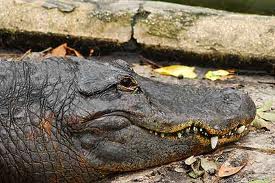
St Augustine Alligator Farm Zoological Park
The St. Augustine Alligator Farm Zoological Park began in the late nineteenth century as a small exhibition of Florida reptiles and became a quintessential Florida attraction. Today it functions as a modern zoo serving the public and the scientific community with educational shows and exhibits, important research and worldwide conservation efforts. The Alligator Farm’s history as an attraction and an accredited zoo is nearly as exciting as zipping across the Alligator Lagoon on Crocodile Crossing, the park’s thrilling new zip-line attraction. Located at 999 Anastasia Blvd. 904.824.3337. Visit
alligatorfarm.com
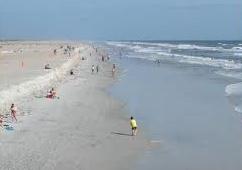
St Augustine Beaches
St. Augustine's beautiful beaches stretch from Vilano Beach north of the city to Crescent Beach in the south. The Intracoastal Waterway naturally divides the mainland from the barrier islands with their miles of gorgeous coastline with many public areas for beach recreation and relaxation. For an overview of St Augustine beaches visit
oldcity.com.
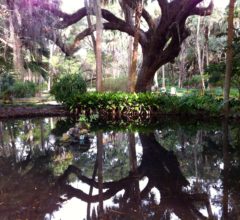
Washington Oaks Gardens State Park
Although the formal gardens are the centerpiece of this park, Washington Oaks is also famous for the unique shoreline of coquina rock formations that line its Atlantic beach. Nestled between the Atlantic Ocean and the Matanzas River, this property was once owned by a distant relative of President George Washington. The gardens were established by Louise and Owen Young who purchased the land in 1936 and built a winter retirement home. They named it Washington Oaks and, in 1965, donated most of the property to the State. The gardens make remarkable use of native and exotic species, from azaleas and camellias to the exquisite bird of paradise, sheltered within a picturesque oak hammock. Located two miles south of Marineland on State Road A1A. Visit
floridastateparks.org

Anastasia State Park
Anastasia State Park includes more than 1,600 acres featuring four miles of pristine beach, a tidal salt marsh, and a maritime and upland hammock. There is also an archaeological site where coquina rock was mined to create the nearby fortress, Castillo de San Marcos National Monument. At Anastasia you can enjoy camping, beachcombing, swimming, picnicking, fishing, windsurfing, hiking, wildlife viewing, boating and more. Anastasia's full-facility campground, including 139 campsites, is located in a wooded area within easy bicycling or walking distance of the beach. A self-guided nature trail takes hikers through a maritime hammock on ancient sand dunes, and anglers have the opportunity to haul in the big catch. 904.460.9111. Visit
floridastateparks.org

Fort Matanzas National Monument
Coastal Florida was a major field of conflict as European nations fought for control in the New World. As part of this struggle, Fort Matanzas guarded St. Augustine’s southern river approach. The colonial wars are over, but the monument is still protecting—not just the historic fort, but also the wild barrier island and the plants and animals who survive there amidst a sea of modern development. The park is situated near the site of the killing of nearly 250 French Huguenots by the Spanish, an act that gave gave the river and inlet the name Matanzas, Spanish for "slaughters", as European nations fought for control of the New World. One hundred seventy-five years later, the small watchtower fort was constructed to help protect St. Augustine from a new threat - the British. Today, the story of survival continues as human pressures encroach upon the peacefulness of the woodlands, beach, and salt marsh. Located at 8635 A1A South. 904.471.0116. Visit
nps.gov

Fort Mose Historic State Park: The Birthplace of Freedom
Hidden away in the marshes of St. Augustine, Florida is one of the most important sites in American history: the first free community of ex-slaves, founded in 1738 and called Gracia Real de Santa Teresa de Mose or Fort Mose. More than a century before the Emancipation Proclamation, slaves from the British colonies were able to follow the original "Underground Railroad" which headed not to the north, but rather south, to the Spanish colony of Florida. There they were given their freedom, if they declared their allegiance to the King of Spain and joined the Catholic Church. Fort Mose was the northern defense of St.Augustine, the nation's oldest city. Learn more about the story of Fort Mose in our newly constructed visitor center and museum or explore the grounds. Located at 15 Fort Mose Trail. 904.823.2232. Visit fortmose.org

Guana Tolomato Matanzas National Estuarine Research Reserve
Guana Tolomato Matanzas National Estuarine Research Reserve is dedicated to the conservation of natural biodiversity and cultural resources through research and monitoring to guide science-based stewardship and education strategies. GTM Research Reserve protects 73,352 acres south of the City of Jacksonville (Duval County) in St. Johns County and Flagler County on the northeast coast of Florida, one of the fastest growing regions in the state. These protected areas provide habitat for a wide variety of fish and wildlife. The Environmental Education Center is located at 505 Guana River Road in Ponte Vedra Beach. 904.823.4500. Visit
GTM Educational Center

St Augustine Alligator Farm Zoological Park
The St. Augustine Alligator Farm Zoological Park began in the late nineteenth century as a small exhibition of Florida reptiles and became a quintessential Florida attraction. Today it functions as a modern zoo serving the public and the scientific community with educational shows and exhibits, important research and worldwide conservation efforts. The Alligator Farm’s history as an attraction and an accredited zoo is nearly as exciting as zipping across the Alligator Lagoon on Crocodile Crossing, the park’s thrilling new zip-line attraction. Located at 999 Anastasia Blvd. 904.824.3337. Visit
alligatorfarm.com

St Augustine Beaches
St. Augustine's beautiful beaches stretch from Vilano Beach north of the city to Crescent Beach in the south. The Intracoastal Waterway naturally divides the mainland from the barrier islands with their miles of gorgeous coastline with many public areas for beach recreation and relaxation. For an overview of St Augustine beaches visit
oldcity.com.

Washington Oaks Gardens State Park
Although the formal gardens are the centerpiece of this park, Washington Oaks is also famous for the unique shoreline of coquina rock formations that line its Atlantic beach. Nestled between the Atlantic Ocean and the Matanzas River, this property was once owned by a distant relative of President George Washington. The gardens were established by Louise and Owen Young who purchased the land in 1936 and built a winter retirement home. They named it Washington Oaks and, in 1965, donated most of the property to the State. The gardens make remarkable use of native and exotic species, from azaleas and camellias to the exquisite bird of paradise, sheltered within a picturesque oak hammock. Located two miles south of Marineland on State Road A1A. Visit
floridastateparks.org











